Evaluation of Programme and Portfolio Management in Crossrail Project
VerifiedAdded on 2023/01/05
|23
|7456
|90
Report
AI Summary
This report examines the significance of programme and portfolio management, particularly within the context of the Crossrail project, a major transportation infrastructure initiative in London. The report evaluates the role of programme and portfolio management in successful project delivery, emphasizing procurement strategies, stakeholder management, and the importance of clear objectives and goals. It analyzes the Crossrail project's procurement strategy, highlighting the roles of program and project delivery partners, and the management of various contracts. The report also synthesizes the latest research on programme and portfolio management, including techniques for project evaluation and resource allocation, aiming to provide investors with the best possible returns. The findings underscore the need for efficient resource management, clear objectives, and a collaborative environment to overcome project challenges and achieve organizational goals, as evidenced by the Crossrail case study and supporting literature. The analysis also covers the importance of project delivery partners and their role in procurement, engineering design, and stakeholder management.
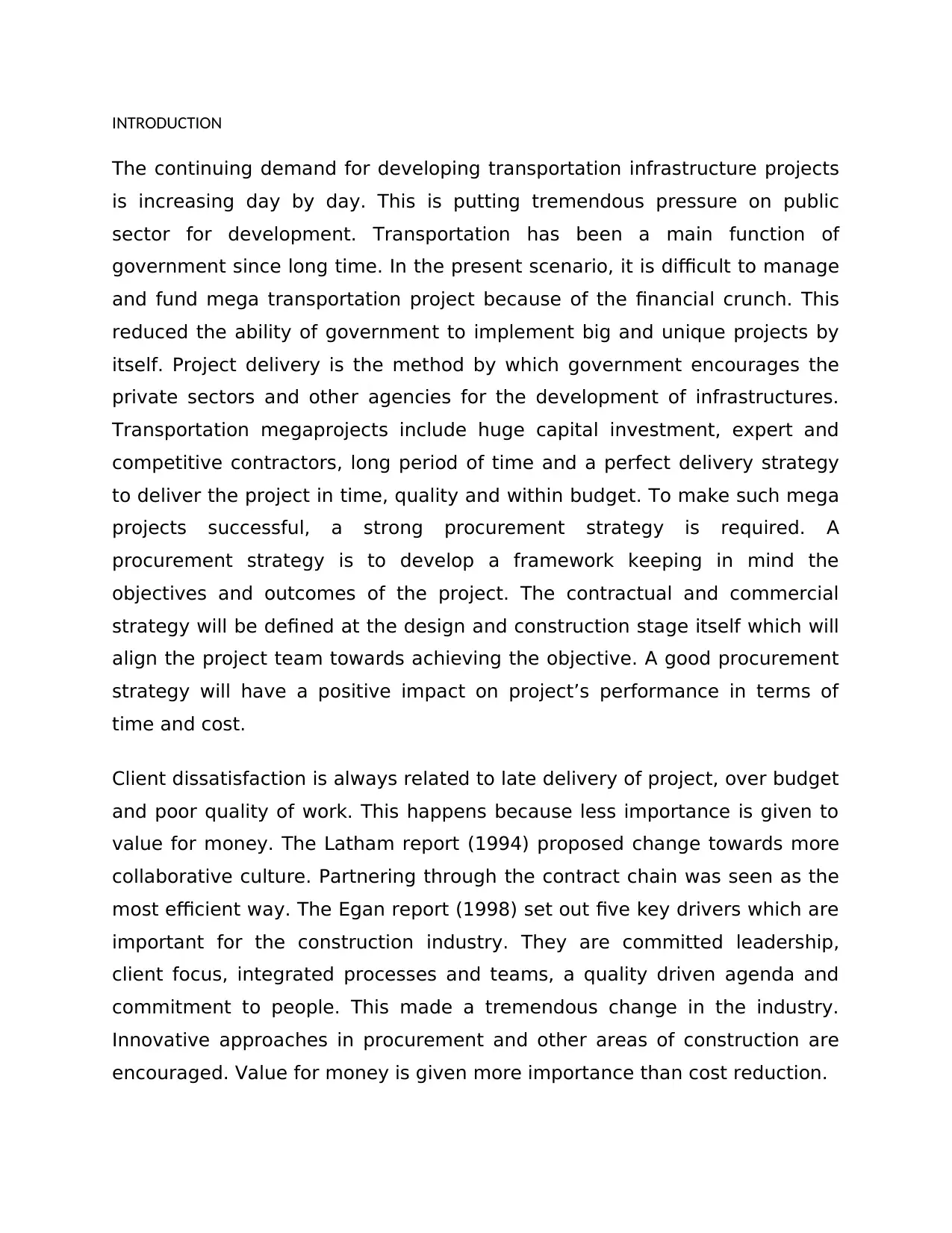
INTRODUCTION
The continuing demand for developing transportation infrastructure projects
is increasing day by day. This is putting tremendous pressure on public
sector for development. Transportation has been a main function of
government since long time. In the present scenario, it is difficult to manage
and fund mega transportation project because of the financial crunch. This
reduced the ability of government to implement big and unique projects by
itself. Project delivery is the method by which government encourages the
private sectors and other agencies for the development of infrastructures.
Transportation megaprojects include huge capital investment, expert and
competitive contractors, long period of time and a perfect delivery strategy
to deliver the project in time, quality and within budget. To make such mega
projects successful, a strong procurement strategy is required. A
procurement strategy is to develop a framework keeping in mind the
objectives and outcomes of the project. The contractual and commercial
strategy will be defined at the design and construction stage itself which will
align the project team towards achieving the objective. A good procurement
strategy will have a positive impact on project’s performance in terms of
time and cost.
Client dissatisfaction is always related to late delivery of project, over budget
and poor quality of work. This happens because less importance is given to
value for money. The Latham report (1994) proposed change towards more
collaborative culture. Partnering through the contract chain was seen as the
most efficient way. The Egan report (1998) set out five key drivers which are
important for the construction industry. They are committed leadership,
client focus, integrated processes and teams, a quality driven agenda and
commitment to people. This made a tremendous change in the industry.
Innovative approaches in procurement and other areas of construction are
encouraged. Value for money is given more importance than cost reduction.
The continuing demand for developing transportation infrastructure projects
is increasing day by day. This is putting tremendous pressure on public
sector for development. Transportation has been a main function of
government since long time. In the present scenario, it is difficult to manage
and fund mega transportation project because of the financial crunch. This
reduced the ability of government to implement big and unique projects by
itself. Project delivery is the method by which government encourages the
private sectors and other agencies for the development of infrastructures.
Transportation megaprojects include huge capital investment, expert and
competitive contractors, long period of time and a perfect delivery strategy
to deliver the project in time, quality and within budget. To make such mega
projects successful, a strong procurement strategy is required. A
procurement strategy is to develop a framework keeping in mind the
objectives and outcomes of the project. The contractual and commercial
strategy will be defined at the design and construction stage itself which will
align the project team towards achieving the objective. A good procurement
strategy will have a positive impact on project’s performance in terms of
time and cost.
Client dissatisfaction is always related to late delivery of project, over budget
and poor quality of work. This happens because less importance is given to
value for money. The Latham report (1994) proposed change towards more
collaborative culture. Partnering through the contract chain was seen as the
most efficient way. The Egan report (1998) set out five key drivers which are
important for the construction industry. They are committed leadership,
client focus, integrated processes and teams, a quality driven agenda and
commitment to people. This made a tremendous change in the industry.
Innovative approaches in procurement and other areas of construction are
encouraged. Value for money is given more importance than cost reduction.
Paraphrase This Document
Need a fresh take? Get an instant paraphrase of this document with our AI Paraphraser
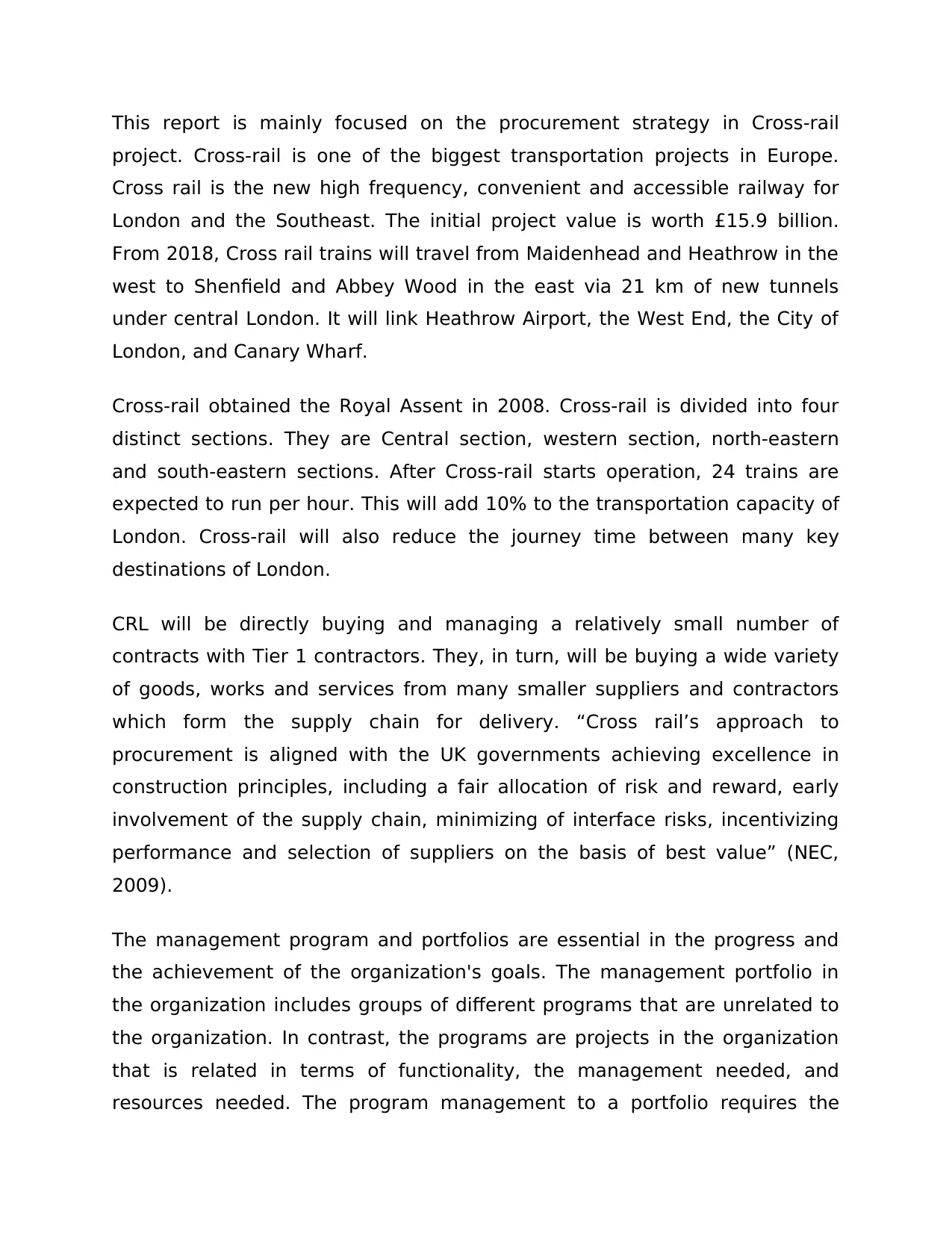
This report is mainly focused on the procurement strategy in Cross-rail
project. Cross-rail is one of the biggest transportation projects in Europe.
Cross rail is the new high frequency, convenient and accessible railway for
London and the Southeast. The initial project value is worth £15.9 billion.
From 2018, Cross rail trains will travel from Maidenhead and Heathrow in the
west to Shenfield and Abbey Wood in the east via 21 km of new tunnels
under central London. It will link Heathrow Airport, the West End, the City of
London, and Canary Wharf.
Cross-rail obtained the Royal Assent in 2008. Cross-rail is divided into four
distinct sections. They are Central section, western section, north-eastern
and south-eastern sections. After Cross-rail starts operation, 24 trains are
expected to run per hour. This will add 10% to the transportation capacity of
London. Cross-rail will also reduce the journey time between many key
destinations of London.
CRL will be directly buying and managing a relatively small number of
contracts with Tier 1 contractors. They, in turn, will be buying a wide variety
of goods, works and services from many smaller suppliers and contractors
which form the supply chain for delivery. “Cross rail’s approach to
procurement is aligned with the UK governments achieving excellence in
construction principles, including a fair allocation of risk and reward, early
involvement of the supply chain, minimizing of interface risks, incentivizing
performance and selection of suppliers on the basis of best value” (NEC,
2009).
The management program and portfolios are essential in the progress and
the achievement of the organization's goals. The management portfolio in
the organization includes groups of different programs that are unrelated to
the organization. In contrast, the programs are projects in the organization
that is related in terms of functionality, the management needed, and
resources needed. The program management to a portfolio requires the
project. Cross-rail is one of the biggest transportation projects in Europe.
Cross rail is the new high frequency, convenient and accessible railway for
London and the Southeast. The initial project value is worth £15.9 billion.
From 2018, Cross rail trains will travel from Maidenhead and Heathrow in the
west to Shenfield and Abbey Wood in the east via 21 km of new tunnels
under central London. It will link Heathrow Airport, the West End, the City of
London, and Canary Wharf.
Cross-rail obtained the Royal Assent in 2008. Cross-rail is divided into four
distinct sections. They are Central section, western section, north-eastern
and south-eastern sections. After Cross-rail starts operation, 24 trains are
expected to run per hour. This will add 10% to the transportation capacity of
London. Cross-rail will also reduce the journey time between many key
destinations of London.
CRL will be directly buying and managing a relatively small number of
contracts with Tier 1 contractors. They, in turn, will be buying a wide variety
of goods, works and services from many smaller suppliers and contractors
which form the supply chain for delivery. “Cross rail’s approach to
procurement is aligned with the UK governments achieving excellence in
construction principles, including a fair allocation of risk and reward, early
involvement of the supply chain, minimizing of interface risks, incentivizing
performance and selection of suppliers on the basis of best value” (NEC,
2009).
The management program and portfolios are essential in the progress and
the achievement of the organization's goals. The management portfolio in
the organization includes groups of different programs that are unrelated to
the organization. In contrast, the programs are projects in the organization
that is related in terms of functionality, the management needed, and
resources needed. The program management to a portfolio requires the
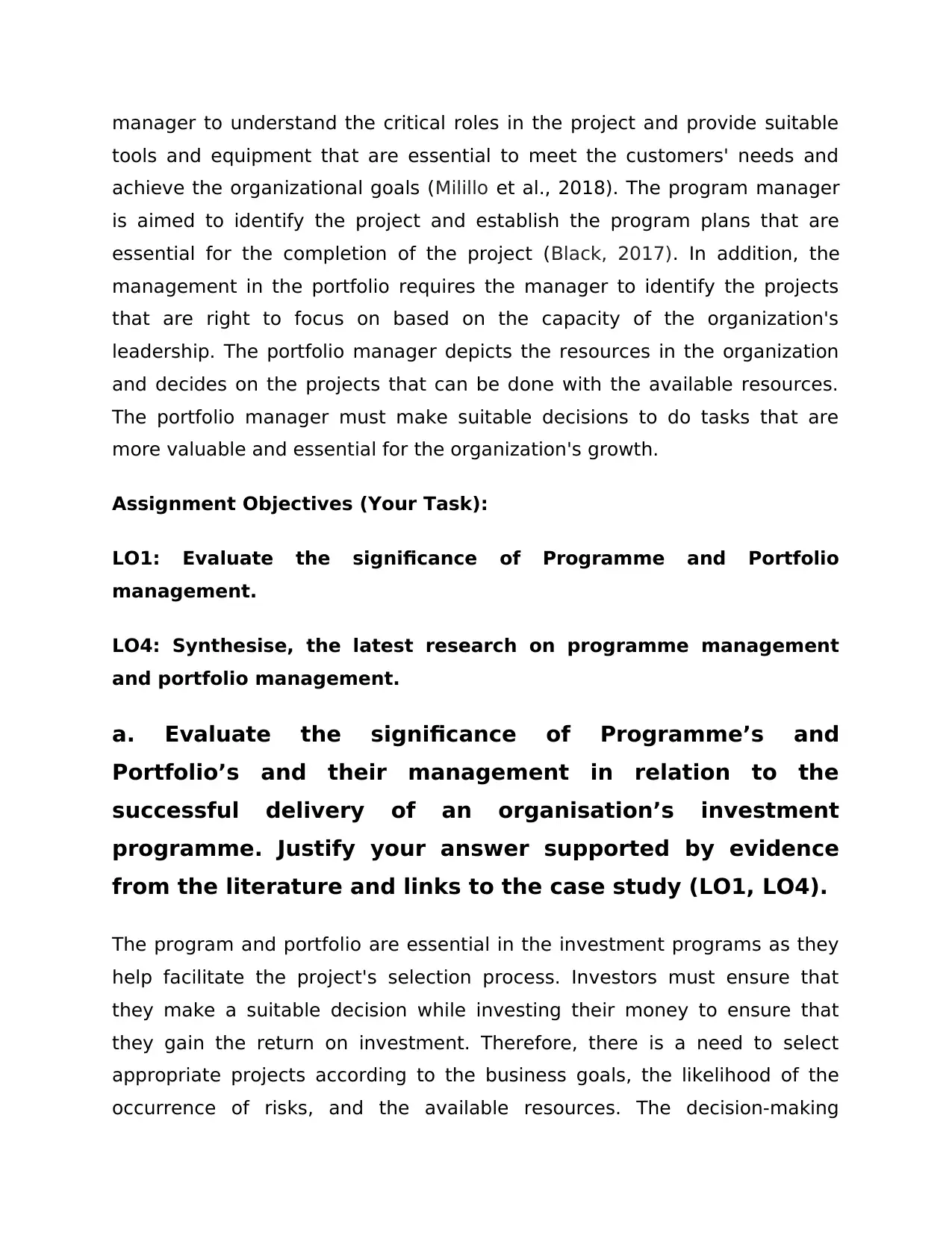
manager to understand the critical roles in the project and provide suitable
tools and equipment that are essential to meet the customers' needs and
achieve the organizational goals (Milillo et al., 2018). The program manager
is aimed to identify the project and establish the program plans that are
essential for the completion of the project (Black, 2017). In addition, the
management in the portfolio requires the manager to identify the projects
that are right to focus on based on the capacity of the organization's
leadership. The portfolio manager depicts the resources in the organization
and decides on the projects that can be done with the available resources.
The portfolio manager must make suitable decisions to do tasks that are
more valuable and essential for the organization's growth.
Assignment Objectives (Your Task):
LO1: Evaluate the significance of Programme and Portfolio
management.
LO4: Synthesise, the latest research on programme management
and portfolio management.
a. Evaluate the significance of Programme’s and
Portfolio’s and their management in relation to the
successful delivery of an organisation’s investment
programme. Justify your answer supported by evidence
from the literature and links to the case study (LO1, LO4).
The program and portfolio are essential in the investment programs as they
help facilitate the project's selection process. Investors must ensure that
they make a suitable decision while investing their money to ensure that
they gain the return on investment. Therefore, there is a need to select
appropriate projects according to the business goals, the likelihood of the
occurrence of risks, and the available resources. The decision-making
tools and equipment that are essential to meet the customers' needs and
achieve the organizational goals (Milillo et al., 2018). The program manager
is aimed to identify the project and establish the program plans that are
essential for the completion of the project (Black, 2017). In addition, the
management in the portfolio requires the manager to identify the projects
that are right to focus on based on the capacity of the organization's
leadership. The portfolio manager depicts the resources in the organization
and decides on the projects that can be done with the available resources.
The portfolio manager must make suitable decisions to do tasks that are
more valuable and essential for the organization's growth.
Assignment Objectives (Your Task):
LO1: Evaluate the significance of Programme and Portfolio
management.
LO4: Synthesise, the latest research on programme management
and portfolio management.
a. Evaluate the significance of Programme’s and
Portfolio’s and their management in relation to the
successful delivery of an organisation’s investment
programme. Justify your answer supported by evidence
from the literature and links to the case study (LO1, LO4).
The program and portfolio are essential in the investment programs as they
help facilitate the project's selection process. Investors must ensure that
they make a suitable decision while investing their money to ensure that
they gain the return on investment. Therefore, there is a need to select
appropriate projects according to the business goals, the likelihood of the
occurrence of risks, and the available resources. The decision-making
⊘ This is a preview!⊘
Do you want full access?
Subscribe today to unlock all pages.

Trusted by 1+ million students worldwide
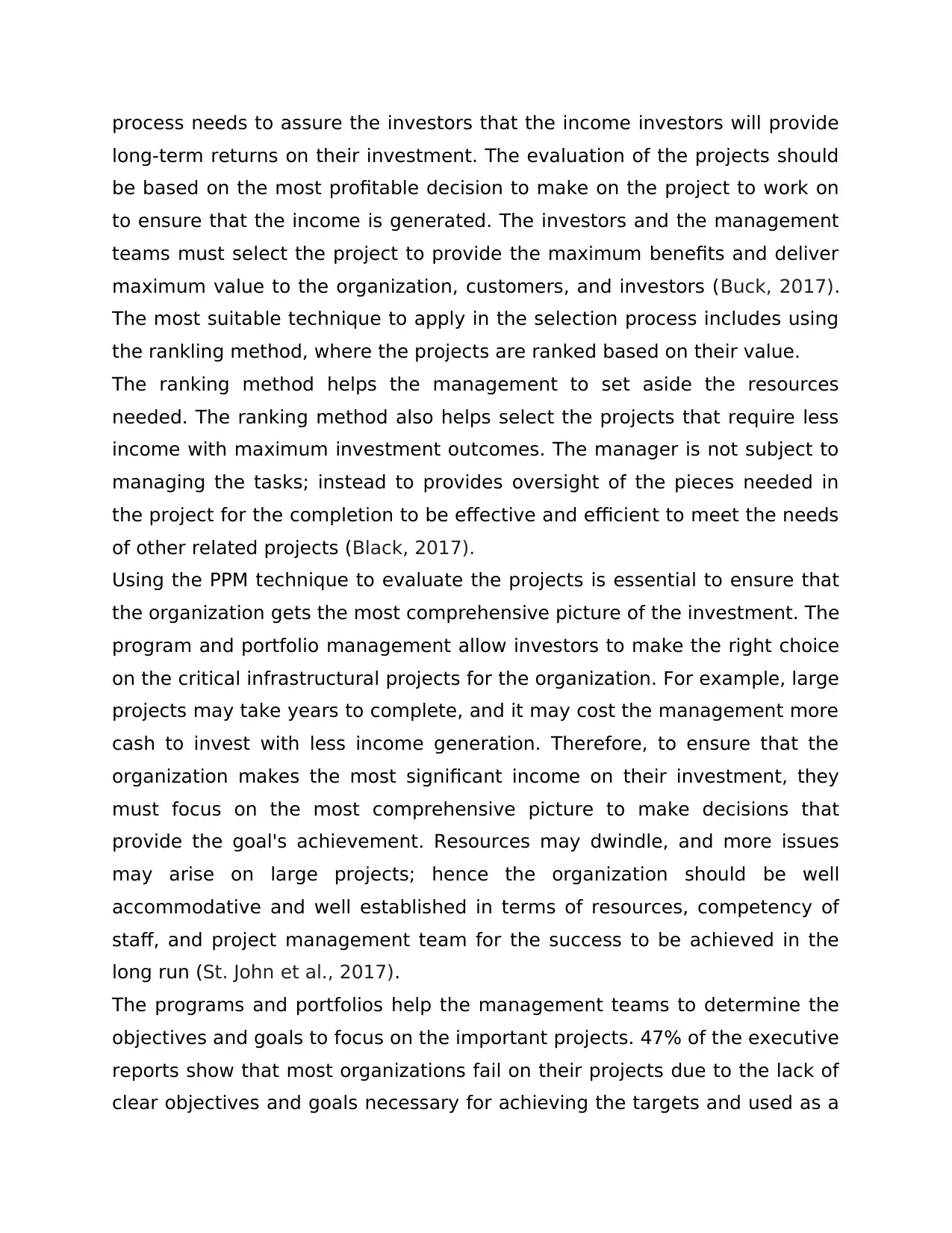
process needs to assure the investors that the income investors will provide
long-term returns on their investment. The evaluation of the projects should
be based on the most profitable decision to make on the project to work on
to ensure that the income is generated. The investors and the management
teams must select the project to provide the maximum benefits and deliver
maximum value to the organization, customers, and investors (Buck, 2017).
The most suitable technique to apply in the selection process includes using
the rankling method, where the projects are ranked based on their value.
The ranking method helps the management to set aside the resources
needed. The ranking method also helps select the projects that require less
income with maximum investment outcomes. The manager is not subject to
managing the tasks; instead to provides oversight of the pieces needed in
the project for the completion to be effective and efficient to meet the needs
of other related projects (Black, 2017).
Using the PPM technique to evaluate the projects is essential to ensure that
the organization gets the most comprehensive picture of the investment. The
program and portfolio management allow investors to make the right choice
on the critical infrastructural projects for the organization. For example, large
projects may take years to complete, and it may cost the management more
cash to invest with less income generation. Therefore, to ensure that the
organization makes the most significant income on their investment, they
must focus on the most comprehensive picture to make decisions that
provide the goal's achievement. Resources may dwindle, and more issues
may arise on large projects; hence the organization should be well
accommodative and well established in terms of resources, competency of
staff, and project management team for the success to be achieved in the
long run (St. John et al., 2017).
The programs and portfolios help the management teams to determine the
objectives and goals to focus on the important projects. 47% of the executive
reports show that most organizations fail on their projects due to the lack of
clear objectives and goals necessary for achieving the targets and used as a
long-term returns on their investment. The evaluation of the projects should
be based on the most profitable decision to make on the project to work on
to ensure that the income is generated. The investors and the management
teams must select the project to provide the maximum benefits and deliver
maximum value to the organization, customers, and investors (Buck, 2017).
The most suitable technique to apply in the selection process includes using
the rankling method, where the projects are ranked based on their value.
The ranking method helps the management to set aside the resources
needed. The ranking method also helps select the projects that require less
income with maximum investment outcomes. The manager is not subject to
managing the tasks; instead to provides oversight of the pieces needed in
the project for the completion to be effective and efficient to meet the needs
of other related projects (Black, 2017).
Using the PPM technique to evaluate the projects is essential to ensure that
the organization gets the most comprehensive picture of the investment. The
program and portfolio management allow investors to make the right choice
on the critical infrastructural projects for the organization. For example, large
projects may take years to complete, and it may cost the management more
cash to invest with less income generation. Therefore, to ensure that the
organization makes the most significant income on their investment, they
must focus on the most comprehensive picture to make decisions that
provide the goal's achievement. Resources may dwindle, and more issues
may arise on large projects; hence the organization should be well
accommodative and well established in terms of resources, competency of
staff, and project management team for the success to be achieved in the
long run (St. John et al., 2017).
The programs and portfolios help the management teams to determine the
objectives and goals to focus on the important projects. 47% of the executive
reports show that most organizations fail on their projects due to the lack of
clear objectives and goals necessary for achieving the targets and used as a
Paraphrase This Document
Need a fresh take? Get an instant paraphrase of this document with our AI Paraphraser
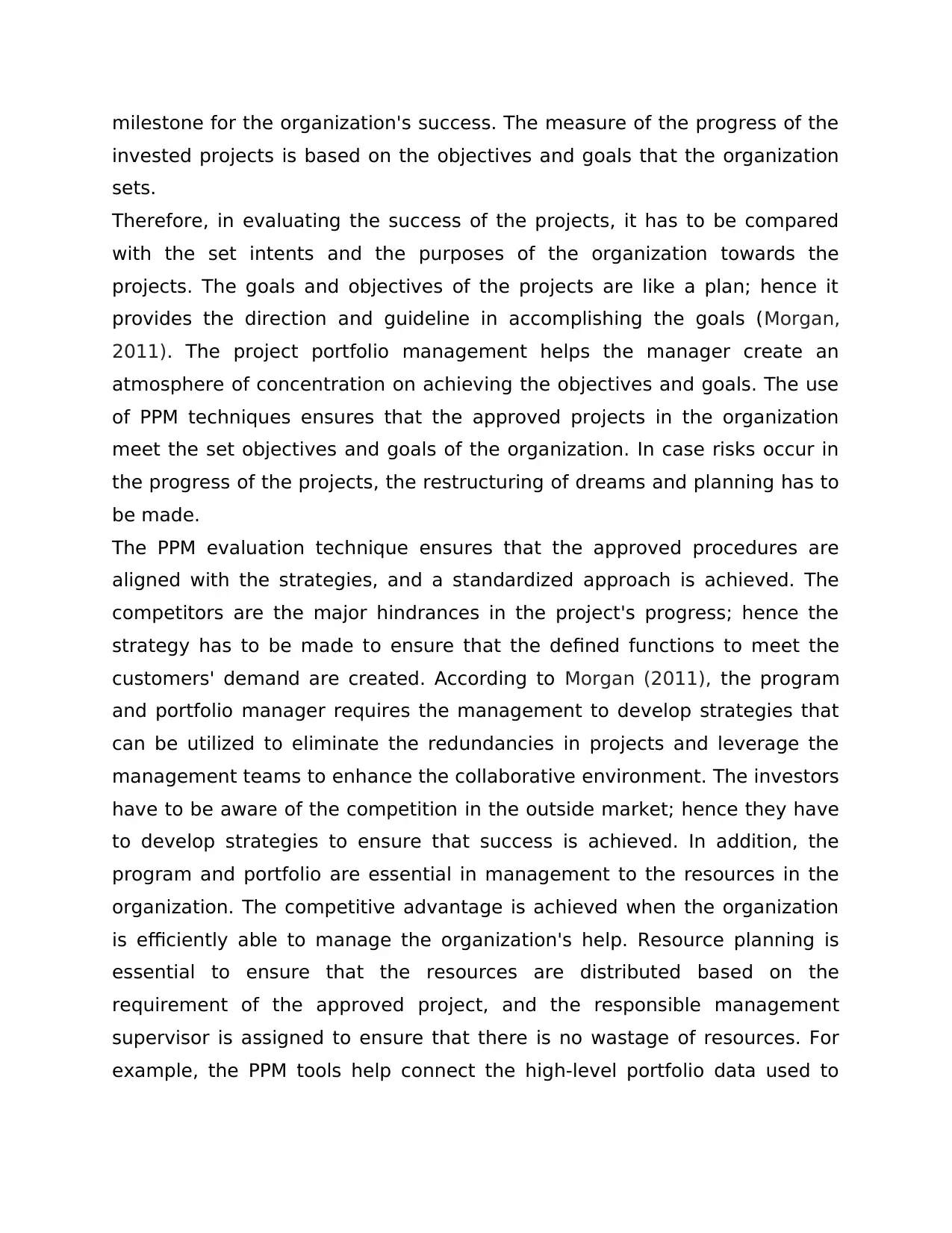
milestone for the organization's success. The measure of the progress of the
invested projects is based on the objectives and goals that the organization
sets.
Therefore, in evaluating the success of the projects, it has to be compared
with the set intents and the purposes of the organization towards the
projects. The goals and objectives of the projects are like a plan; hence it
provides the direction and guideline in accomplishing the goals (Morgan,
2011). The project portfolio management helps the manager create an
atmosphere of concentration on achieving the objectives and goals. The use
of PPM techniques ensures that the approved projects in the organization
meet the set objectives and goals of the organization. In case risks occur in
the progress of the projects, the restructuring of dreams and planning has to
be made.
The PPM evaluation technique ensures that the approved procedures are
aligned with the strategies, and a standardized approach is achieved. The
competitors are the major hindrances in the project's progress; hence the
strategy has to be made to ensure that the defined functions to meet the
customers' demand are created. According to Morgan (2011), the program
and portfolio manager requires the management to develop strategies that
can be utilized to eliminate the redundancies in projects and leverage the
management teams to enhance the collaborative environment. The investors
have to be aware of the competition in the outside market; hence they have
to develop strategies to ensure that success is achieved. In addition, the
program and portfolio are essential in management to the resources in the
organization. The competitive advantage is achieved when the organization
is efficiently able to manage the organization's help. Resource planning is
essential to ensure that the resources are distributed based on the
requirement of the approved project, and the responsible management
supervisor is assigned to ensure that there is no wastage of resources. For
example, the PPM tools help connect the high-level portfolio data used to
invested projects is based on the objectives and goals that the organization
sets.
Therefore, in evaluating the success of the projects, it has to be compared
with the set intents and the purposes of the organization towards the
projects. The goals and objectives of the projects are like a plan; hence it
provides the direction and guideline in accomplishing the goals (Morgan,
2011). The project portfolio management helps the manager create an
atmosphere of concentration on achieving the objectives and goals. The use
of PPM techniques ensures that the approved projects in the organization
meet the set objectives and goals of the organization. In case risks occur in
the progress of the projects, the restructuring of dreams and planning has to
be made.
The PPM evaluation technique ensures that the approved procedures are
aligned with the strategies, and a standardized approach is achieved. The
competitors are the major hindrances in the project's progress; hence the
strategy has to be made to ensure that the defined functions to meet the
customers' demand are created. According to Morgan (2011), the program
and portfolio manager requires the management to develop strategies that
can be utilized to eliminate the redundancies in projects and leverage the
management teams to enhance the collaborative environment. The investors
have to be aware of the competition in the outside market; hence they have
to develop strategies to ensure that success is achieved. In addition, the
program and portfolio are essential in management to the resources in the
organization. The competitive advantage is achieved when the organization
is efficiently able to manage the organization's help. Resource planning is
essential to ensure that the resources are distributed based on the
requirement of the approved project, and the responsible management
supervisor is assigned to ensure that there is no wastage of resources. For
example, the PPM tools help connect the high-level portfolio data used to
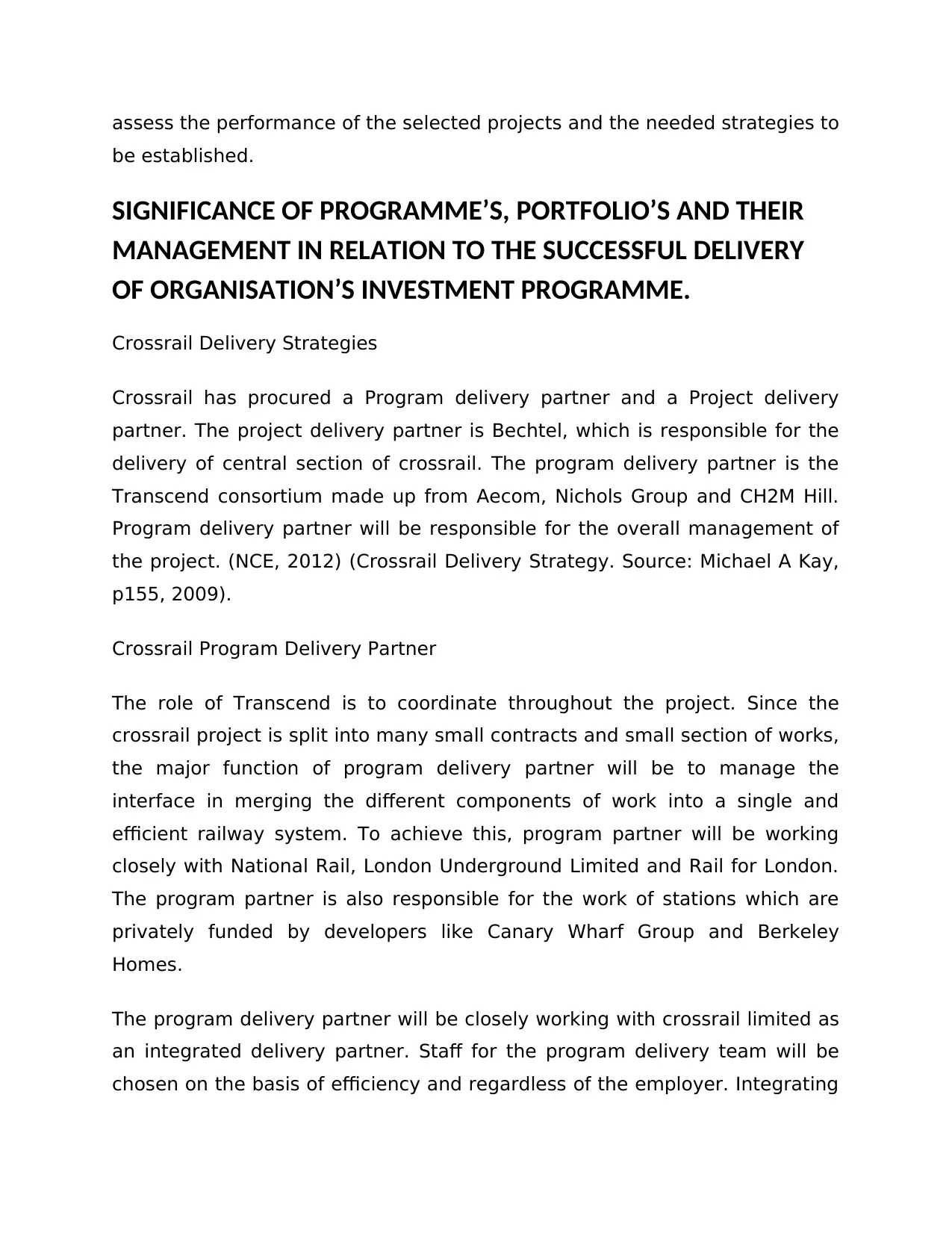
assess the performance of the selected projects and the needed strategies to
be established.
SIGNIFICANCE OF PROGRAMME’S, PORTFOLIO’S AND THEIR
MANAGEMENT IN RELATION TO THE SUCCESSFUL DELIVERY
OF ORGANISATION’S INVESTMENT PROGRAMME.
Crossrail Delivery Strategies
Crossrail has procured a Program delivery partner and a Project delivery
partner. The project delivery partner is Bechtel, which is responsible for the
delivery of central section of crossrail. The program delivery partner is the
Transcend consortium made up from Aecom, Nichols Group and CH2M Hill.
Program delivery partner will be responsible for the overall management of
the project. (NCE, 2012) (Crossrail Delivery Strategy. Source: Michael A Kay,
p155, 2009).
Crossrail Program Delivery Partner
The role of Transcend is to coordinate throughout the project. Since the
crossrail project is split into many small contracts and small section of works,
the major function of program delivery partner will be to manage the
interface in merging the different components of work into a single and
efficient railway system. To achieve this, program partner will be working
closely with National Rail, London Underground Limited and Rail for London.
The program partner is also responsible for the work of stations which are
privately funded by developers like Canary Wharf Group and Berkeley
Homes.
The program delivery partner will be closely working with crossrail limited as
an integrated delivery partner. Staff for the program delivery team will be
chosen on the basis of efficiency and regardless of the employer. Integrating
be established.
SIGNIFICANCE OF PROGRAMME’S, PORTFOLIO’S AND THEIR
MANAGEMENT IN RELATION TO THE SUCCESSFUL DELIVERY
OF ORGANISATION’S INVESTMENT PROGRAMME.
Crossrail Delivery Strategies
Crossrail has procured a Program delivery partner and a Project delivery
partner. The project delivery partner is Bechtel, which is responsible for the
delivery of central section of crossrail. The program delivery partner is the
Transcend consortium made up from Aecom, Nichols Group and CH2M Hill.
Program delivery partner will be responsible for the overall management of
the project. (NCE, 2012) (Crossrail Delivery Strategy. Source: Michael A Kay,
p155, 2009).
Crossrail Program Delivery Partner
The role of Transcend is to coordinate throughout the project. Since the
crossrail project is split into many small contracts and small section of works,
the major function of program delivery partner will be to manage the
interface in merging the different components of work into a single and
efficient railway system. To achieve this, program partner will be working
closely with National Rail, London Underground Limited and Rail for London.
The program partner is also responsible for the work of stations which are
privately funded by developers like Canary Wharf Group and Berkeley
Homes.
The program delivery partner will be closely working with crossrail limited as
an integrated delivery partner. Staff for the program delivery team will be
chosen on the basis of efficiency and regardless of the employer. Integrating
⊘ This is a preview!⊘
Do you want full access?
Subscribe today to unlock all pages.

Trusted by 1+ million students worldwide
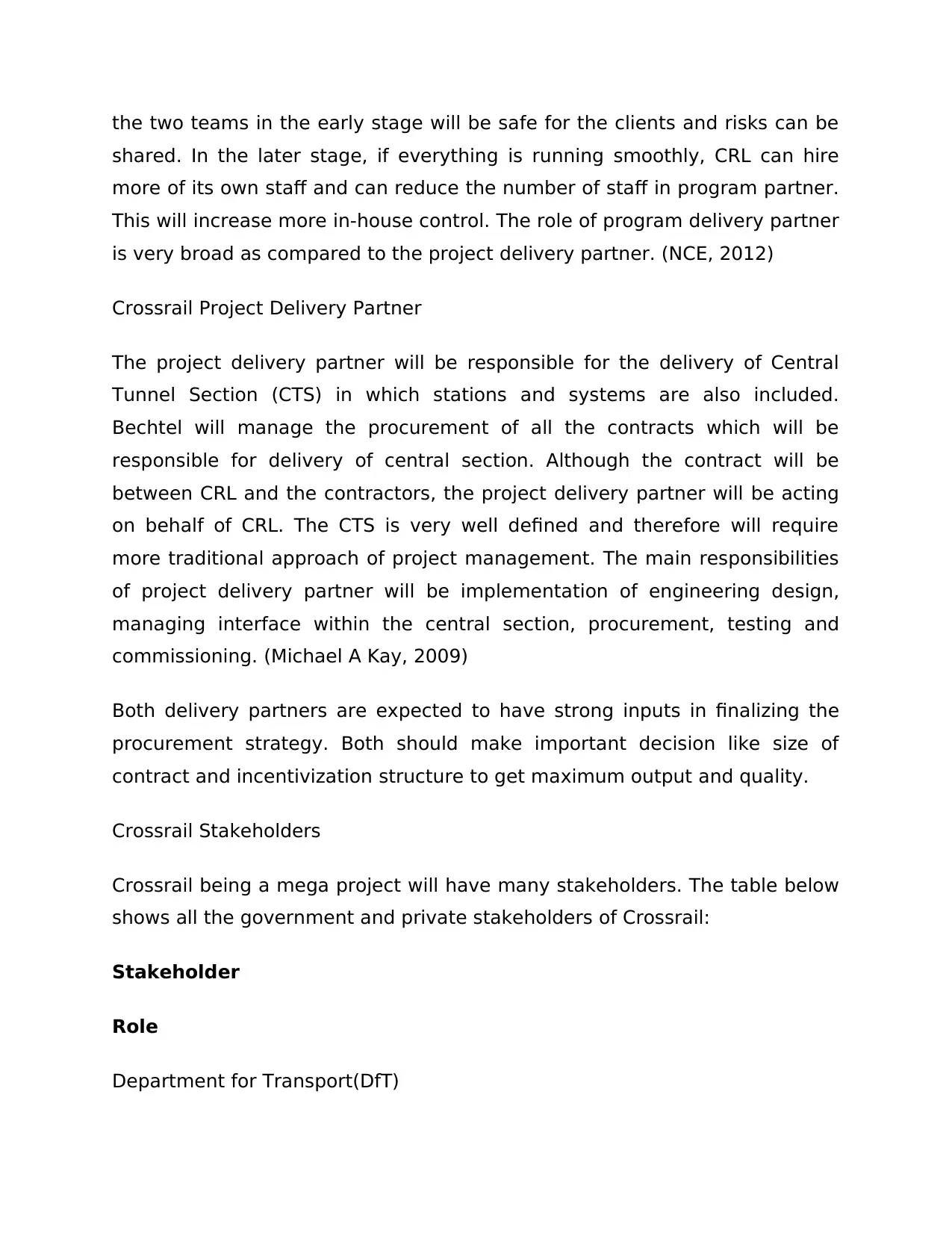
the two teams in the early stage will be safe for the clients and risks can be
shared. In the later stage, if everything is running smoothly, CRL can hire
more of its own staff and can reduce the number of staff in program partner.
This will increase more in-house control. The role of program delivery partner
is very broad as compared to the project delivery partner. (NCE, 2012)
Crossrail Project Delivery Partner
The project delivery partner will be responsible for the delivery of Central
Tunnel Section (CTS) in which stations and systems are also included.
Bechtel will manage the procurement of all the contracts which will be
responsible for delivery of central section. Although the contract will be
between CRL and the contractors, the project delivery partner will be acting
on behalf of CRL. The CTS is very well defined and therefore will require
more traditional approach of project management. The main responsibilities
of project delivery partner will be implementation of engineering design,
managing interface within the central section, procurement, testing and
commissioning. (Michael A Kay, 2009)
Both delivery partners are expected to have strong inputs in finalizing the
procurement strategy. Both should make important decision like size of
contract and incentivization structure to get maximum output and quality.
Crossrail Stakeholders
Crossrail being a mega project will have many stakeholders. The table below
shows all the government and private stakeholders of Crossrail:
Stakeholder
Role
Department for Transport(DfT)
shared. In the later stage, if everything is running smoothly, CRL can hire
more of its own staff and can reduce the number of staff in program partner.
This will increase more in-house control. The role of program delivery partner
is very broad as compared to the project delivery partner. (NCE, 2012)
Crossrail Project Delivery Partner
The project delivery partner will be responsible for the delivery of Central
Tunnel Section (CTS) in which stations and systems are also included.
Bechtel will manage the procurement of all the contracts which will be
responsible for delivery of central section. Although the contract will be
between CRL and the contractors, the project delivery partner will be acting
on behalf of CRL. The CTS is very well defined and therefore will require
more traditional approach of project management. The main responsibilities
of project delivery partner will be implementation of engineering design,
managing interface within the central section, procurement, testing and
commissioning. (Michael A Kay, 2009)
Both delivery partners are expected to have strong inputs in finalizing the
procurement strategy. Both should make important decision like size of
contract and incentivization structure to get maximum output and quality.
Crossrail Stakeholders
Crossrail being a mega project will have many stakeholders. The table below
shows all the government and private stakeholders of Crossrail:
Stakeholder
Role
Department for Transport(DfT)
Paraphrase This Document
Need a fresh take? Get an instant paraphrase of this document with our AI Paraphraser
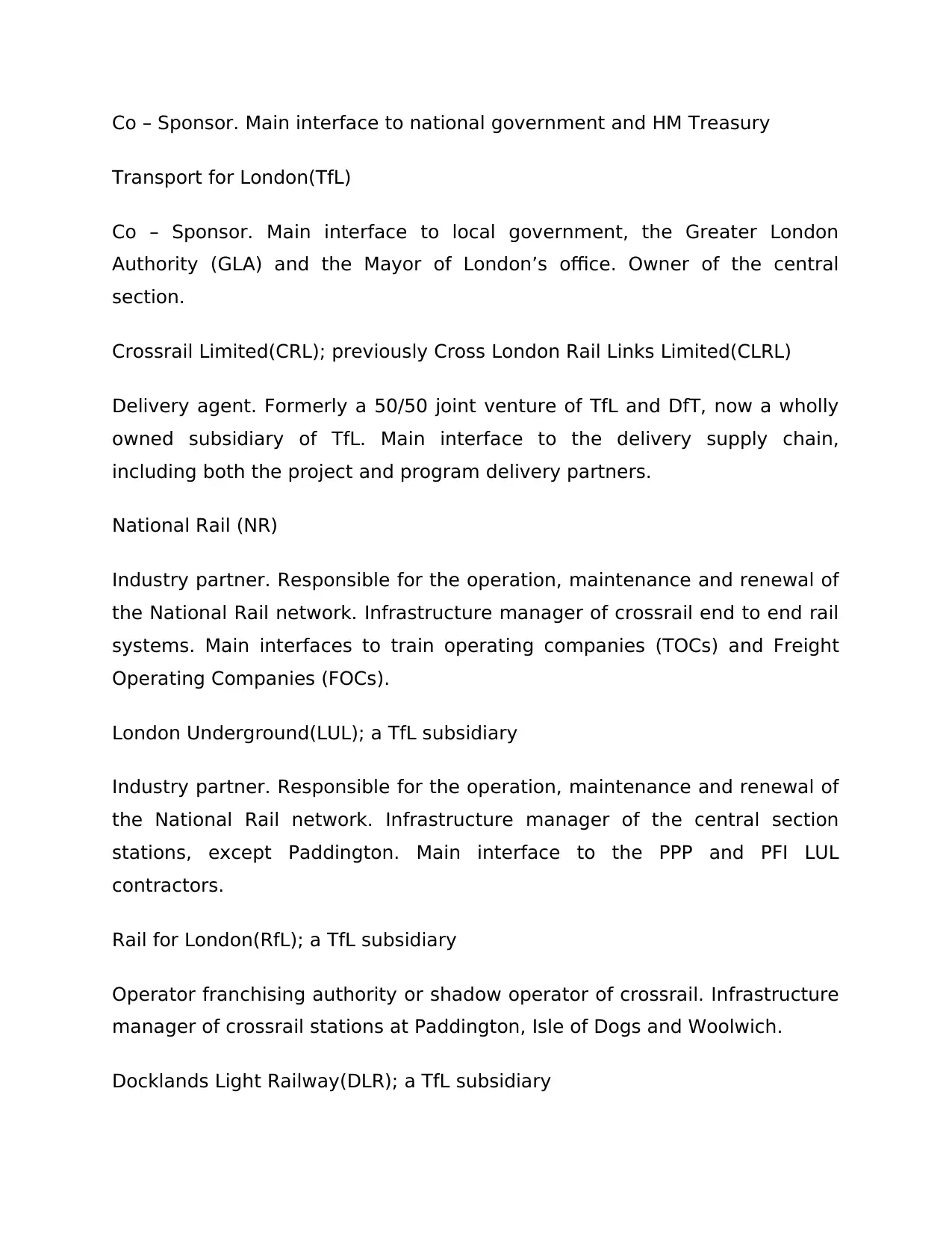
Co – Sponsor. Main interface to national government and HM Treasury
Transport for London(TfL)
Co – Sponsor. Main interface to local government, the Greater London
Authority (GLA) and the Mayor of London’s office. Owner of the central
section.
Crossrail Limited(CRL); previously Cross London Rail Links Limited(CLRL)
Delivery agent. Formerly a 50/50 joint venture of TfL and DfT, now a wholly
owned subsidiary of TfL. Main interface to the delivery supply chain,
including both the project and program delivery partners.
National Rail (NR)
Industry partner. Responsible for the operation, maintenance and renewal of
the National Rail network. Infrastructure manager of crossrail end to end rail
systems. Main interfaces to train operating companies (TOCs) and Freight
Operating Companies (FOCs).
London Underground(LUL); a TfL subsidiary
Industry partner. Responsible for the operation, maintenance and renewal of
the National Rail network. Infrastructure manager of the central section
stations, except Paddington. Main interface to the PPP and PFI LUL
contractors.
Rail for London(RfL); a TfL subsidiary
Operator franchising authority or shadow operator of crossrail. Infrastructure
manager of crossrail stations at Paddington, Isle of Dogs and Woolwich.
Docklands Light Railway(DLR); a TfL subsidiary
Transport for London(TfL)
Co – Sponsor. Main interface to local government, the Greater London
Authority (GLA) and the Mayor of London’s office. Owner of the central
section.
Crossrail Limited(CRL); previously Cross London Rail Links Limited(CLRL)
Delivery agent. Formerly a 50/50 joint venture of TfL and DfT, now a wholly
owned subsidiary of TfL. Main interface to the delivery supply chain,
including both the project and program delivery partners.
National Rail (NR)
Industry partner. Responsible for the operation, maintenance and renewal of
the National Rail network. Infrastructure manager of crossrail end to end rail
systems. Main interfaces to train operating companies (TOCs) and Freight
Operating Companies (FOCs).
London Underground(LUL); a TfL subsidiary
Industry partner. Responsible for the operation, maintenance and renewal of
the National Rail network. Infrastructure manager of the central section
stations, except Paddington. Main interface to the PPP and PFI LUL
contractors.
Rail for London(RfL); a TfL subsidiary
Operator franchising authority or shadow operator of crossrail. Infrastructure
manager of crossrail stations at Paddington, Isle of Dogs and Woolwich.
Docklands Light Railway(DLR); a TfL subsidiary
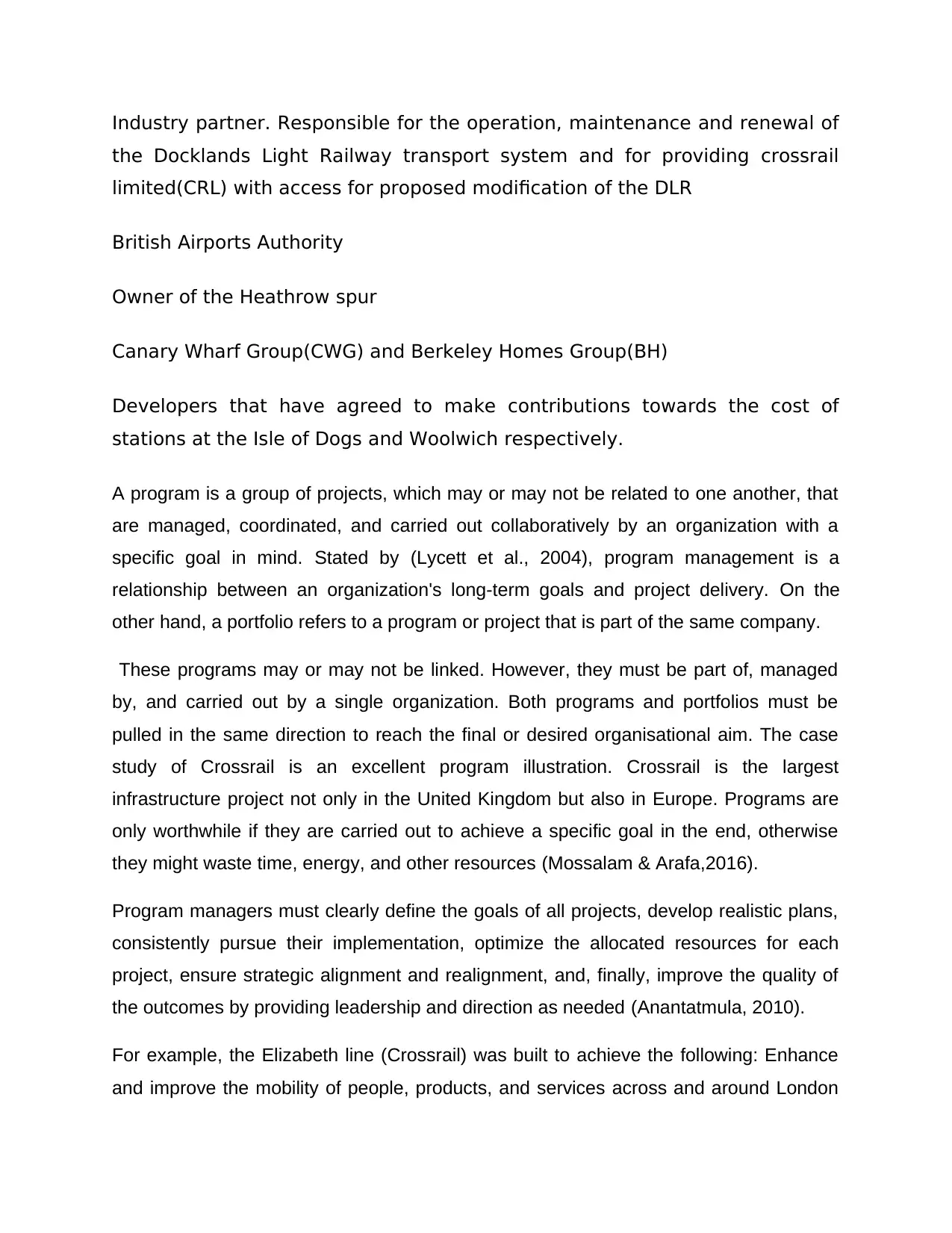
Industry partner. Responsible for the operation, maintenance and renewal of
the Docklands Light Railway transport system and for providing crossrail
limited(CRL) with access for proposed modification of the DLR
British Airports Authority
Owner of the Heathrow spur
Canary Wharf Group(CWG) and Berkeley Homes Group(BH)
Developers that have agreed to make contributions towards the cost of
stations at the Isle of Dogs and Woolwich respectively.
A program is a group of projects, which may or may not be related to one another, that
are managed, coordinated, and carried out collaboratively by an organization with a
specific goal in mind. Stated by (Lycett et al., 2004), program management is a
relationship between an organization's long-term goals and project delivery. On the
other hand, a portfolio refers to a program or project that is part of the same company.
These programs may or may not be linked. However, they must be part of, managed
by, and carried out by a single organization. Both programs and portfolios must be
pulled in the same direction to reach the final or desired organisational aim. The case
study of Crossrail is an excellent program illustration. Crossrail is the largest
infrastructure project not only in the United Kingdom but also in Europe. Programs are
only worthwhile if they are carried out to achieve a specific goal in the end, otherwise
they might waste time, energy, and other resources (Mossalam & Arafa,2016).
Program managers must clearly define the goals of all projects, develop realistic plans,
consistently pursue their implementation, optimize the allocated resources for each
project, ensure strategic alignment and realignment, and, finally, improve the quality of
the outcomes by providing leadership and direction as needed (Anantatmula, 2010).
For example, the Elizabeth line (Crossrail) was built to achieve the following: Enhance
and improve the mobility of people, products, and services across and around London
the Docklands Light Railway transport system and for providing crossrail
limited(CRL) with access for proposed modification of the DLR
British Airports Authority
Owner of the Heathrow spur
Canary Wharf Group(CWG) and Berkeley Homes Group(BH)
Developers that have agreed to make contributions towards the cost of
stations at the Isle of Dogs and Woolwich respectively.
A program is a group of projects, which may or may not be related to one another, that
are managed, coordinated, and carried out collaboratively by an organization with a
specific goal in mind. Stated by (Lycett et al., 2004), program management is a
relationship between an organization's long-term goals and project delivery. On the
other hand, a portfolio refers to a program or project that is part of the same company.
These programs may or may not be linked. However, they must be part of, managed
by, and carried out by a single organization. Both programs and portfolios must be
pulled in the same direction to reach the final or desired organisational aim. The case
study of Crossrail is an excellent program illustration. Crossrail is the largest
infrastructure project not only in the United Kingdom but also in Europe. Programs are
only worthwhile if they are carried out to achieve a specific goal in the end, otherwise
they might waste time, energy, and other resources (Mossalam & Arafa,2016).
Program managers must clearly define the goals of all projects, develop realistic plans,
consistently pursue their implementation, optimize the allocated resources for each
project, ensure strategic alignment and realignment, and, finally, improve the quality of
the outcomes by providing leadership and direction as needed (Anantatmula, 2010).
For example, the Elizabeth line (Crossrail) was built to achieve the following: Enhance
and improve the mobility of people, products, and services across and around London
⊘ This is a preview!⊘
Do you want full access?
Subscribe today to unlock all pages.

Trusted by 1+ million students worldwide
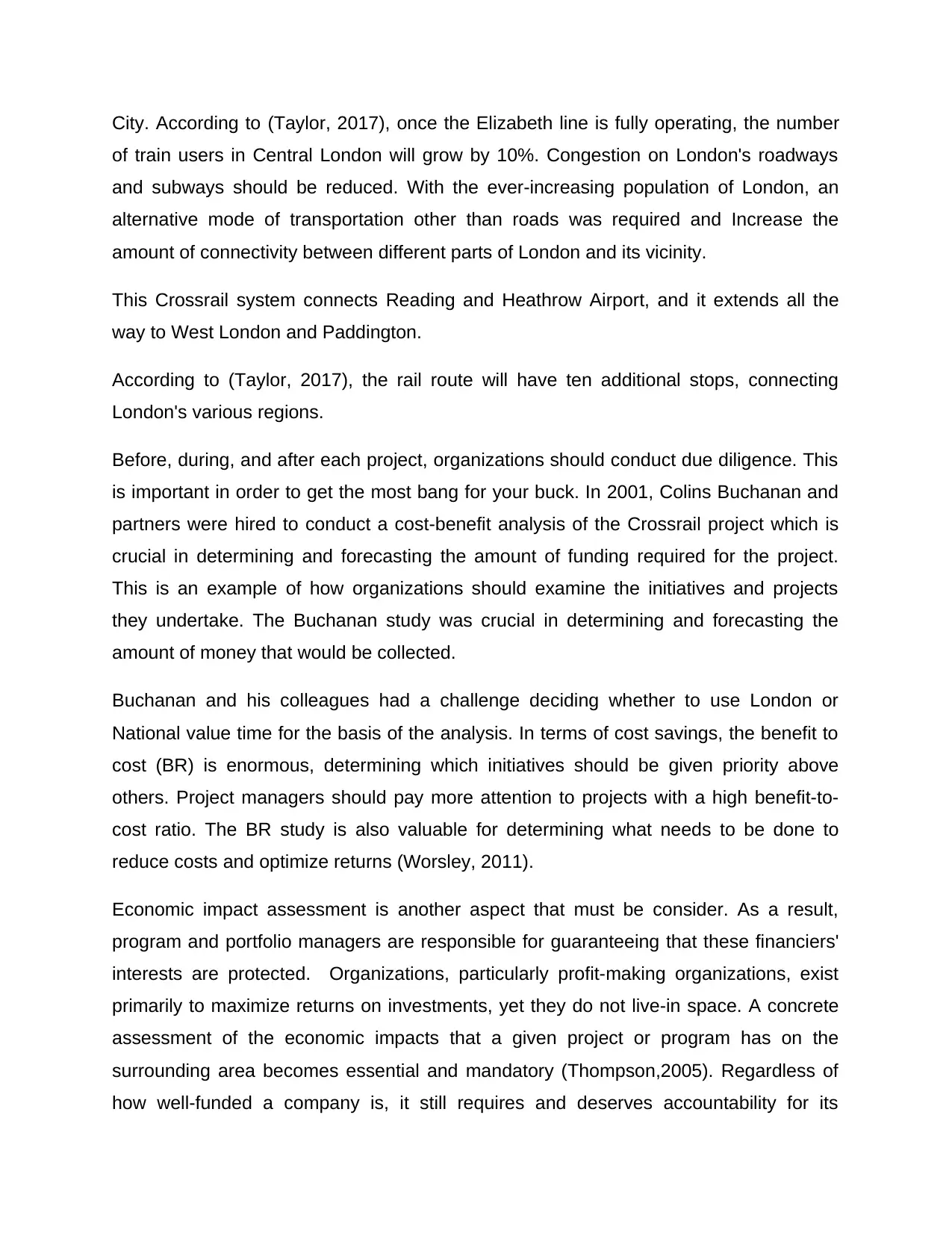
City. According to (Taylor, 2017), once the Elizabeth line is fully operating, the number
of train users in Central London will grow by 10%. Congestion on London's roadways
and subways should be reduced. With the ever-increasing population of London, an
alternative mode of transportation other than roads was required and Increase the
amount of connectivity between different parts of London and its vicinity.
This Crossrail system connects Reading and Heathrow Airport, and it extends all the
way to West London and Paddington.
According to (Taylor, 2017), the rail route will have ten additional stops, connecting
London's various regions.
Before, during, and after each project, organizations should conduct due diligence. This
is important in order to get the most bang for your buck. In 2001, Colins Buchanan and
partners were hired to conduct a cost-benefit analysis of the Crossrail project which is
crucial in determining and forecasting the amount of funding required for the project.
This is an example of how organizations should examine the initiatives and projects
they undertake. The Buchanan study was crucial in determining and forecasting the
amount of money that would be collected.
Buchanan and his colleagues had a challenge deciding whether to use London or
National value time for the basis of the analysis. In terms of cost savings, the benefit to
cost (BR) is enormous, determining which initiatives should be given priority above
others. Project managers should pay more attention to projects with a high benefit-to-
cost ratio. The BR study is also valuable for determining what needs to be done to
reduce costs and optimize returns (Worsley, 2011).
Economic impact assessment is another aspect that must be consider. As a result,
program and portfolio managers are responsible for guaranteeing that these financiers'
interests are protected. Organizations, particularly profit-making organizations, exist
primarily to maximize returns on investments, yet they do not live-in space. A concrete
assessment of the economic impacts that a given project or program has on the
surrounding area becomes essential and mandatory (Thompson,2005). Regardless of
how well-funded a company is, it still requires and deserves accountability for its
of train users in Central London will grow by 10%. Congestion on London's roadways
and subways should be reduced. With the ever-increasing population of London, an
alternative mode of transportation other than roads was required and Increase the
amount of connectivity between different parts of London and its vicinity.
This Crossrail system connects Reading and Heathrow Airport, and it extends all the
way to West London and Paddington.
According to (Taylor, 2017), the rail route will have ten additional stops, connecting
London's various regions.
Before, during, and after each project, organizations should conduct due diligence. This
is important in order to get the most bang for your buck. In 2001, Colins Buchanan and
partners were hired to conduct a cost-benefit analysis of the Crossrail project which is
crucial in determining and forecasting the amount of funding required for the project.
This is an example of how organizations should examine the initiatives and projects
they undertake. The Buchanan study was crucial in determining and forecasting the
amount of money that would be collected.
Buchanan and his colleagues had a challenge deciding whether to use London or
National value time for the basis of the analysis. In terms of cost savings, the benefit to
cost (BR) is enormous, determining which initiatives should be given priority above
others. Project managers should pay more attention to projects with a high benefit-to-
cost ratio. The BR study is also valuable for determining what needs to be done to
reduce costs and optimize returns (Worsley, 2011).
Economic impact assessment is another aspect that must be consider. As a result,
program and portfolio managers are responsible for guaranteeing that these financiers'
interests are protected. Organizations, particularly profit-making organizations, exist
primarily to maximize returns on investments, yet they do not live-in space. A concrete
assessment of the economic impacts that a given project or program has on the
surrounding area becomes essential and mandatory (Thompson,2005). Regardless of
how well-funded a company is, it still requires and deserves accountability for its
Paraphrase This Document
Need a fresh take? Get an instant paraphrase of this document with our AI Paraphraser
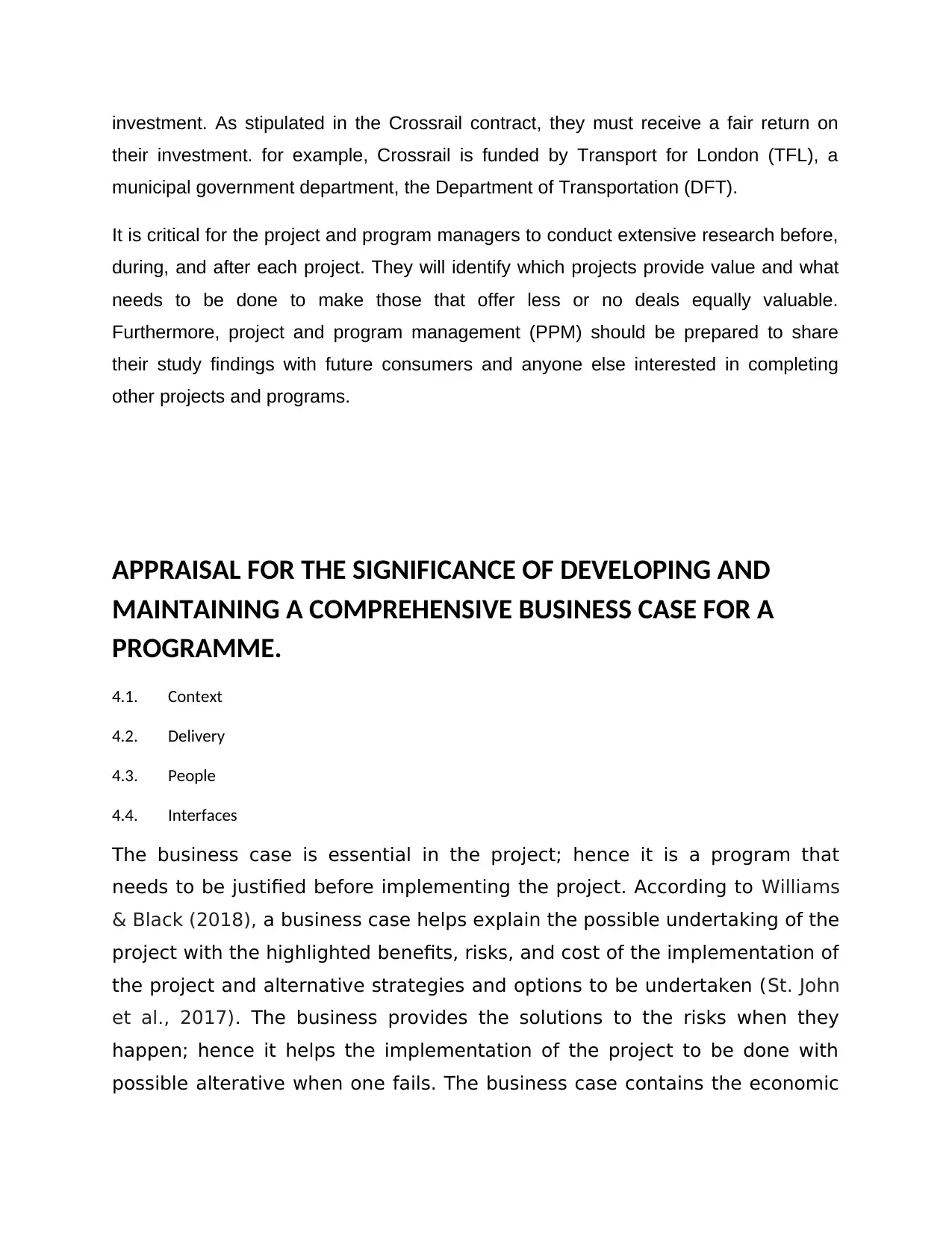
investment. As stipulated in the Crossrail contract, they must receive a fair return on
their investment. for example, Crossrail is funded by Transport for London (TFL), a
municipal government department, the Department of Transportation (DFT).
It is critical for the project and program managers to conduct extensive research before,
during, and after each project. They will identify which projects provide value and what
needs to be done to make those that offer less or no deals equally valuable.
Furthermore, project and program management (PPM) should be prepared to share
their study findings with future consumers and anyone else interested in completing
other projects and programs.
APPRAISAL FOR THE SIGNIFICANCE OF DEVELOPING AND
MAINTAINING A COMPREHENSIVE BUSINESS CASE FOR A
PROGRAMME.
4.1. Context
4.2. Delivery
4.3. People
4.4. Interfaces
The business case is essential in the project; hence it is a program that
needs to be justified before implementing the project. According to Williams
& Black (2018), a business case helps explain the possible undertaking of the
project with the highlighted benefits, risks, and cost of the implementation of
the project and alternative strategies and options to be undertaken (St. John
et al., 2017). The business provides the solutions to the risks when they
happen; hence it helps the implementation of the project to be done with
possible alterative when one fails. The business case contains the economic
their investment. for example, Crossrail is funded by Transport for London (TFL), a
municipal government department, the Department of Transportation (DFT).
It is critical for the project and program managers to conduct extensive research before,
during, and after each project. They will identify which projects provide value and what
needs to be done to make those that offer less or no deals equally valuable.
Furthermore, project and program management (PPM) should be prepared to share
their study findings with future consumers and anyone else interested in completing
other projects and programs.
APPRAISAL FOR THE SIGNIFICANCE OF DEVELOPING AND
MAINTAINING A COMPREHENSIVE BUSINESS CASE FOR A
PROGRAMME.
4.1. Context
4.2. Delivery
4.3. People
4.4. Interfaces
The business case is essential in the project; hence it is a program that
needs to be justified before implementing the project. According to Williams
& Black (2018), a business case helps explain the possible undertaking of the
project with the highlighted benefits, risks, and cost of the implementation of
the project and alternative strategies and options to be undertaken (St. John
et al., 2017). The business provides the solutions to the risks when they
happen; hence it helps the implementation of the project to be done with
possible alterative when one fails. The business case contains the economic
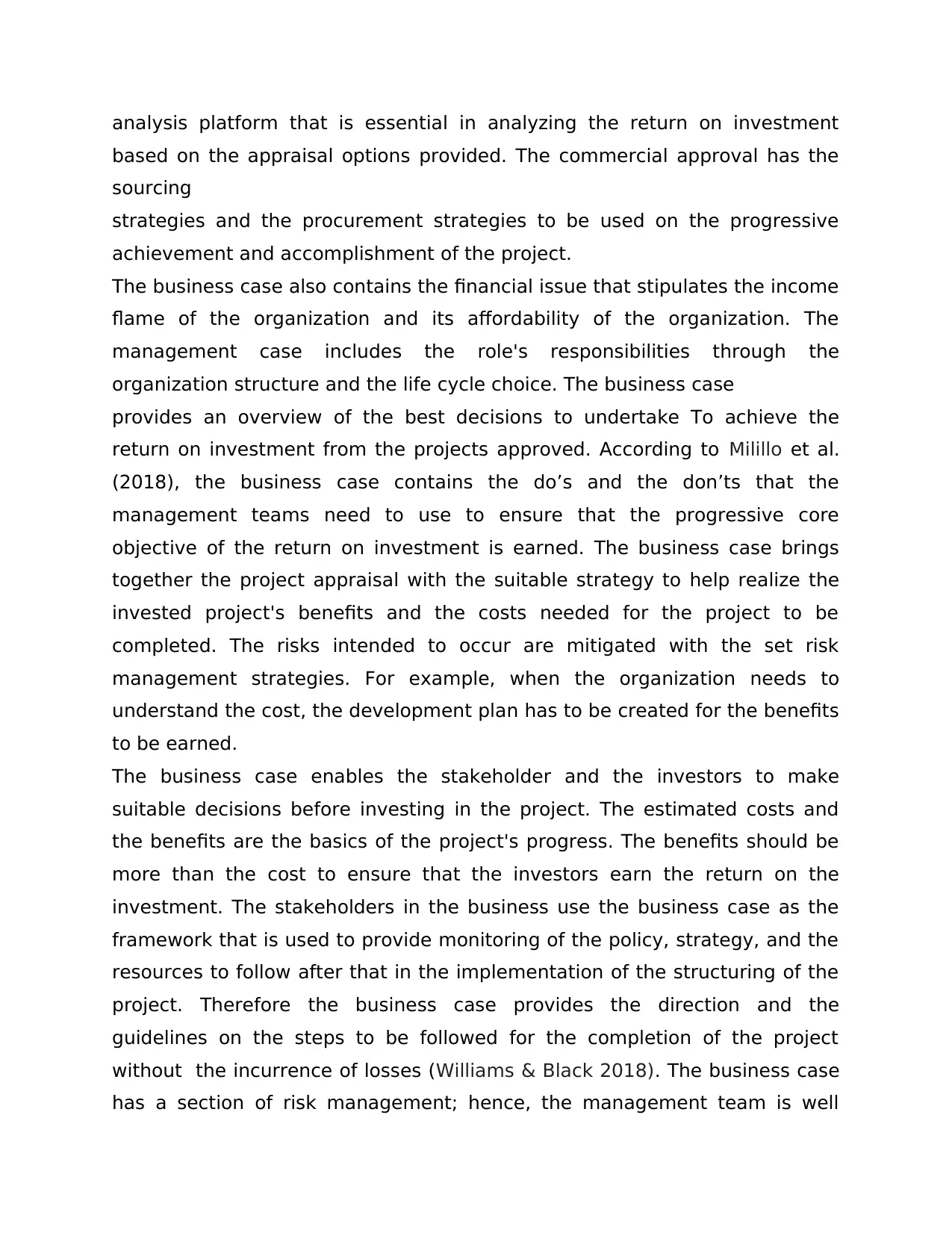
analysis platform that is essential in analyzing the return on investment
based on the appraisal options provided. The commercial approval has the
sourcing
strategies and the procurement strategies to be used on the progressive
achievement and accomplishment of the project.
The business case also contains the financial issue that stipulates the income
flame of the organization and its affordability of the organization. The
management case includes the role's responsibilities through the
organization structure and the life cycle choice. The business case
provides an overview of the best decisions to undertake To achieve the
return on investment from the projects approved. According to Milillo et al.
(2018), the business case contains the do’s and the don’ts that the
management teams need to use to ensure that the progressive core
objective of the return on investment is earned. The business case brings
together the project appraisal with the suitable strategy to help realize the
invested project's benefits and the costs needed for the project to be
completed. The risks intended to occur are mitigated with the set risk
management strategies. For example, when the organization needs to
understand the cost, the development plan has to be created for the benefits
to be earned.
The business case enables the stakeholder and the investors to make
suitable decisions before investing in the project. The estimated costs and
the benefits are the basics of the project's progress. The benefits should be
more than the cost to ensure that the investors earn the return on the
investment. The stakeholders in the business use the business case as the
framework that is used to provide monitoring of the policy, strategy, and the
resources to follow after that in the implementation of the structuring of the
project. Therefore the business case provides the direction and the
guidelines on the steps to be followed for the completion of the project
without the incurrence of losses (Williams & Black 2018). The business case
has a section of risk management; hence, the management team is well
based on the appraisal options provided. The commercial approval has the
sourcing
strategies and the procurement strategies to be used on the progressive
achievement and accomplishment of the project.
The business case also contains the financial issue that stipulates the income
flame of the organization and its affordability of the organization. The
management case includes the role's responsibilities through the
organization structure and the life cycle choice. The business case
provides an overview of the best decisions to undertake To achieve the
return on investment from the projects approved. According to Milillo et al.
(2018), the business case contains the do’s and the don’ts that the
management teams need to use to ensure that the progressive core
objective of the return on investment is earned. The business case brings
together the project appraisal with the suitable strategy to help realize the
invested project's benefits and the costs needed for the project to be
completed. The risks intended to occur are mitigated with the set risk
management strategies. For example, when the organization needs to
understand the cost, the development plan has to be created for the benefits
to be earned.
The business case enables the stakeholder and the investors to make
suitable decisions before investing in the project. The estimated costs and
the benefits are the basics of the project's progress. The benefits should be
more than the cost to ensure that the investors earn the return on the
investment. The stakeholders in the business use the business case as the
framework that is used to provide monitoring of the policy, strategy, and the
resources to follow after that in the implementation of the structuring of the
project. Therefore the business case provides the direction and the
guidelines on the steps to be followed for the completion of the project
without the incurrence of losses (Williams & Black 2018). The business case
has a section of risk management; hence, the management team is well
⊘ This is a preview!⊘
Do you want full access?
Subscribe today to unlock all pages.

Trusted by 1+ million students worldwide
1 out of 23
Related Documents
Your All-in-One AI-Powered Toolkit for Academic Success.
+13062052269
info@desklib.com
Available 24*7 on WhatsApp / Email
![[object Object]](/_next/static/media/star-bottom.7253800d.svg)
Unlock your academic potential
Copyright © 2020–2025 A2Z Services. All Rights Reserved. Developed and managed by ZUCOL.





